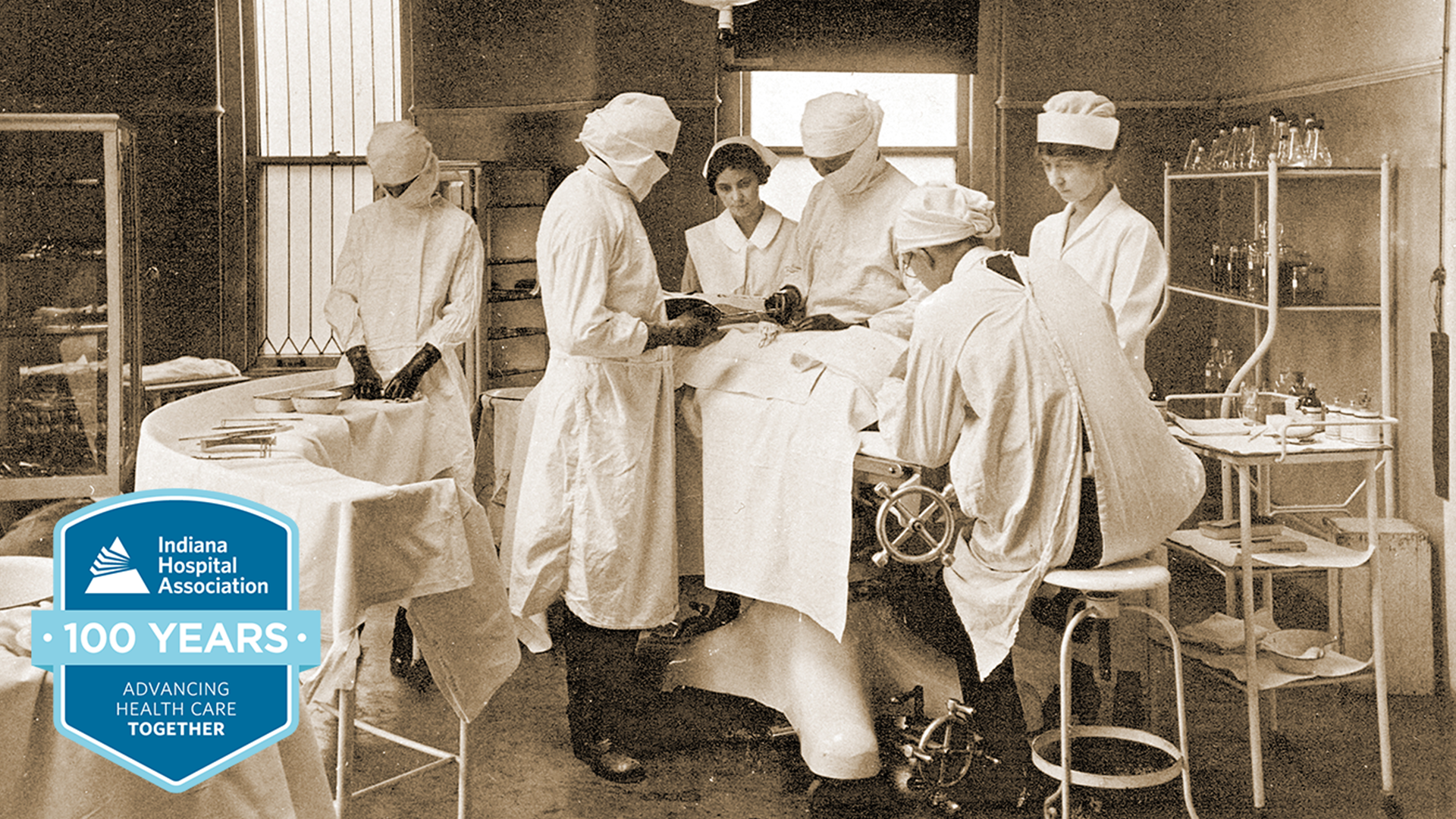 2021 marks the 100th anniversary of the Indiana Hospital Association (IHA)’s founding. It’s no coincidence that 1921 was also the year President Harding declared the first National Hospital Day. As the nation was still recovering from the Spanish flu epidemic that killed millions across the globe, it was deemed in the national interest to educate Americans about new treatments, increase the health care workforce, and strengthen the public health system. In our centenary year as an Association, we find ourselves again with the imperative to collaborate, transform, and to tell our story.
2021 marks the 100th anniversary of the Indiana Hospital Association (IHA)’s founding. It’s no coincidence that 1921 was also the year President Harding declared the first National Hospital Day. As the nation was still recovering from the Spanish flu epidemic that killed millions across the globe, it was deemed in the national interest to educate Americans about new treatments, increase the health care workforce, and strengthen the public health system. In our centenary year as an Association, we find ourselves again with the imperative to collaborate, transform, and to tell our story.
Since IHA’s inception, health care has advanced drastically. John Render, who served as IHA’s legal counsel for nearly 50 years, reflects on his lifelong career in health care, identifying significant growth and change, but also many similarities along the way. Render recalls the devastating outbreak of polio in the 1950s and the development of the polio vaccine which brought dramatic change.
“It was the same sentiment then as it is now. The vaccine brought hope and a bright future for Indiana,” said Render.
Render, who originally was a high school English teacher, said his greatest influence to go into law was one of his high school teachers. He was the first in his family to go to college, let alone form Hall, Render, Killian, Heath & Lyman, P.C., a nationwide health care law firm, which he helped establish in 1968.
Render spent decades advocating on behalf of hospitals at the Indiana state legislature and in Washington as a founding partner at Hall Render. He explained that IHA has always had a great working relationship with the Indiana General Assembly and Indiana’s Congressional delegation. IHA always focused on big picture issues like expanding coverage, fighting regulations, and fair reimbursement for hospitals. Render often heard stories of other states battling over less significant issues.
“IHA’s rapport with lawmakers is unmatched at the Statehouse,” Render said. “This is good for hospitals, but it’s even better for Hoosiers. We always tried to be more public-oriented than self-serving. These relationships ultimately helped advance health care into what it is today.”
Former IHA President Ken Stella echoed Render’s comments.
“Having a unified voice is crucial when addressing issues that will benefit an organization,” said Stella. “If there are multiple voices, the legislature does not have to respond. My ideal scenario was to encourage groups to go behind closed doors, debate our positions and beliefs, and then work to compromise our differences. When we left that room, we left with one united voice,” he said.
Stella served as the president of IHA for 23 years, from 1984 to 2007. Stella did not realize his summer college work experience at LaRue Carter Hospital would lead him to his Indiana health administration career.
“I am honored to be part of an organization that has transformed health care for 100 years and counting,” said Stella.
Doug Leonard served as IHA president for 10 years, from 2007 to 2017, after working at Columbus Regional Hospital for nearly 30 years, including serving as CEO. Before becoming IHA president, Leonard was Chairman of the IHA Board of Directors for two years. Leonard says the biggest health care issue during his tenure was working towards Medicaid expansion in the form of HIP 2.0. Leonard operated on the premise that “the money should follow the patient,” with fairness and transparency being at the forefront.
“The legislative team of Sally Cleveland, Tim Kennedy, and Brian Tabor were just outstanding,” said Leonard. “They represented IHA in the manner established by Bill Hall, John Render, Ken Stella, and David Windley. We always came down on the side of what is best for the public on any contentious issues. They exuded honesty, transparency, and integrity,” he said.
 Brian Tabor, IHA President
Brian Tabor, IHA President
Brian Tabor, IHA’s current president who has led the association since 2017, reflects on those memorable days.
“I would have to say the single most indelible moment of my career to-date was watching Doug Leonard sign the agreement with Governor Pence’s administration to launch the HIP 2.0 program,” said Tabor.
“Hospitals worked for months, tirelessly advocating for expanding coverage,” he said. “The IHA Board of Directors showed tremendous leadership and unity during negotiations on financing and other details, ultimately making what some thought to be a remote possibility a reality for uninsured Hoosiers,” said Tabor.
“As I look back, I cannot imagine navigating an opioid abuse epidemic followed by a pandemic without HIP and the security it provides for hundreds of thousands of Hoosier citizens.”
Fast forward to March 6, 2020, when Indiana had its first confirmed case of COVID-19. IHA assisted member hospitals in their response efforts to treat and constantly adapt to the ever-changing virus, from adding intensive care units and ventilators to testing and vaccinating Hoosiers. Many rural hospitals nationwide had to close their doors due to the cancelation of elective surgeries. Thankfully, no hospitals were closed in Indiana during this challenging time.
Tabor says the pandemic proved the value of speaking with one, unified voice.
“The collaboration between all types of hospital members throughout the pandemic was remarkable and I have never been prouder of Indiana’s hospitals,” he said. “The needs of rural hospitals may sometimes differ from those in metropolitan areas, but I think our large and inclusive board ensures that we address all of the varying priorities. But when the State of Indiana or our Congressional delegation needed rapid responses from IHA on critical issues, we had amazing staff who presented IHA’s elected leadership with the data they needed to make decisions that best reflected all members’ interests. Seeing this process in action made me appreciate that this is what the Association’s founders intended 100 years ago.”
It is now 2021 and it has been 100 years since IHA opened its doors. Innovative new laws like telemedicine expansion were recently passed into law.
“This form of treatment came at the right time as COVID-19 made it difficult for many of us to make it to the doctor for care,” said Render.
“We have made leaps and bounds in our telehealth capabilities and that’s a win for patients,” said Tabor. “But technology can never replace the essential role of the caregiver. Patients and their families will always need someone who calms them before treatment, advocates that help address the root cause of their symptoms, and more,” he said. “I think the beauty of health care is the human connection, and that will not change no matter how much technology evolves.”
In order to have a successful next 100 years, the message is clear. All IHA presidents – past and current – say preserving coverage, quality, and access will be key, along with the overarching principle the association was founded upon; the power of speaking with one, unified voice.
“The last year has been a historically difficult year, but it highlighted the tremendous responsibility of hospitals and IHA,” said Tabor. “As I reflect on the past 100 years, I immediately think of an IHA Harmony letter from 1937 that hangs in our office sent from Albert Hahn, the first chairman of the Association to members across the state,” he said.
The letter urged hospital leaders to write letters and wire messages to the governor and legislative leaders opposing a harmful bill being debated in the General Assembly.
“Our tactics may be different today as we leverage email and social media, but the core mission is the same—to advocate for Hoosier hospitals and make it easier to serve their patients and communities,” he said. “If we can remain as unified and engaged as we have throughout our first 100 years, I am confident that we will continue expanding coverage, improving care, and making Indiana a healthier state.”
Read more about IHA's history
here.
